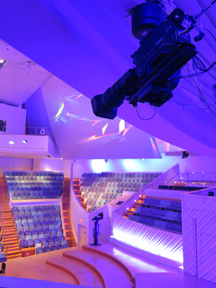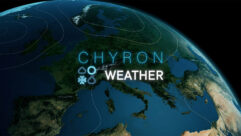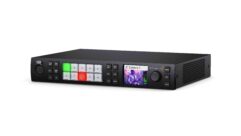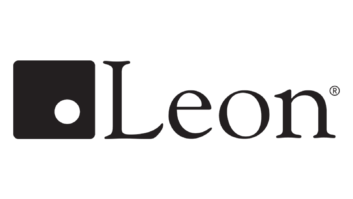
SVC Podcast – Show Notes – Show 168-2
In this edition of the SVC Podcast, SVC Contributing Editor Bennett Liles talks with Roberto Toledo, Director of Audio with Miami’s New World Symphony about their sensational Wallcasts that have been electrifying Miami Beach crowds for several years. Along with the huge seven thousand square foot projection they must have equally big sound and the Meyer Sound Constellation system specially tuned for the outdoors delivers it.
For Part 1
Links of interest:
Download Podcast Here:
https://s3.amazonaws.com/nb-svc/public/public/New_World_Symphony_Toledo_…
This is the SVC Podcast with Roberto Toledo of the New World Symphony. Show notes and equipment links can be found on the website of Sound & Video Contractor Magazine at svconline.com.
Miami’s New World Symphony has been performing their famous Wallcasts for several years now and the crowds keep getting bigger. Along with the video advance to 4K cameras the sound system has had some very innovative design advances as well. Audio Director Roberto Toledo is here to tell us about how their Meyer Constellation System is set up and run. Coming up on the SVC Podcast.
Now we turn to the sound side of things and what would a symphony broadcast be without that? With us is Roberto Toledo, Director of Audio at the New World Symphony and you have been doing big things with the Wallcasts. Physically big things!
Yes.
You’re using a Meyer Sound Constellation system but I don’t think I’ve ever heard of one that runs outside. We’ve had several podcasts on venues with it changing the interior acoustics but that must be an interesting setup on it dealing with ambient sound in the open air. Is that unique to this venue and did you have any special challenges to setting it up and configuring it?
It’s definitely a unique system. The Constellation is really used for interior spaces. I’ve seen it used for restaurants. I think the usual use is concert halls where they’ll have a small hall and then they can make it bigger by using Constellation. From what I also understand, and you’ll have to verify this, but I think Constellation was also used for Star Wars on Tour to create an artificial shell for the musicians so they could hear themselves better. So it’s definitely had a lot of applications, but as far as I know this is the first time it’s been used to basically create an environment outdoors. So in a typical Constellation system, from what I’ve learned from Meyer, is that you have the Constellation microphones and the Constellation speakers all in the same room. We’re doing it so that all the Constellation microphones are actually inside the performance space and all the Constellation speakers are outside. And then what they do is they take the Constellation microphones along with what we call our recording microphones, process them, run them through their digital reverberators known as VRAS and then they’re matrixed out to the speakers which create the ambiance. So that’s how we’re using it. And as far as dealing with the outdoor environment you get used to it. You’d be surprised. I don’t think I’ve ever run into a problem where Miami Beach, and especially South Beach, has caused any problems for us where we couldn’t hear the concert. I mean occasionally you’ll hear an ambulance go by or a fire truck go by or some kind of siren or a plane go over or motorcycle is really loud. But it’s surprisingly quite quiet for a concert. So I do adjust levels as I go so if something becomes a little too obnoxious I can raise the level to sort of overpower it enough so you can hear it, but I’ve gotten so used to it now it doesn’t really bother me anymore I’m just used to hearing the ambiance so it’s just become part of the show. The audience is very quiet. They pay attention. They’re very attentive. People get angry when you talk or talk on your cell phone or make noises on your cell phone. So it’s really nice to know that the audience is very captivated by what we’re doing and take it very seriously when they’re here. It’s free for them, but they treat it as if you were in a paid performance hall, so that’s really great that our audience truly enjoys the shows. [Timestamp: 3:30]
So how do all of the sound signals, the mix, get out to the amps, the speakers and the Constellation system from inside the building?
The Meyer D-Mitri system. So Constellation is sort of a combination of Meyer hardware with microphones and speakers. So it’s an entire Meyer system with the exception of Constellation mics which are DPA microphones, these little tiny little microphones that are hanging in the hall. But the core system is a Meyer D-Mitri system and we use their software CueStation, which is basically just a big software mixer, to run it all. It’s fairly straightforward. The first time that I saw it I was slightly taken aback because I was expecting something else and it’s just a big software mixer. You have inputs, outputs buses, a matrix. And everything has a fader, EQ, compressor, limiters, delays, you know, the usual. So I go out there with a laptop, audio goes into the processors, to the input devices, it’s processed and then sent to the output devices. And then those output devices, it’s like 155-line outputs, go to the speakers. So that’s how the signal was routed in the park system. [Timestamp: 4:34]
Alright so you’re controlling the mix. Are you outside when you’re doing that or somewhere inside the building?
Outside. We have a spot pretty much dead center. It’s actually the spot where Meyer came in when they were setting up the system and tuning it and doing initial sound checking back in 2010 and 2011. I saw them sitting in this one spot so I decided well, why don’t I just sit where they were testing and go from there? It’s actually a good spot. It’s not too close to the front and it’s not too close to the back. It’s not exactly the sweet spot of the park. The sweet spot of the park is actually about 10-15 feet behind me, but it’s a good center spot to gauge overall loudness of the park system. [Timestamp: 5:13]
And you’re right out there in the middle of the crowd so you can judge their reaction and see if it’s having the desired effect.
Yes. Right away.
Wow, that must be great. I would feel a little weird sitting inside and mixing for outside anyway.
The first time I did it was very nerve-racking because we were doing the first Wallcast and I was learning so many different things when we first opened; learning the hall, learning all the audio systems, and then on top of that doing a Wallcast. But now it’s become so, for lack of a better word, easy that I don’t really notice the audience that much. I mean I notice when we have a big audience, but once a how gets going I’m kind of in my own little world when I’m mixing. So I do pay attention to what they’re doing but a lot of people have become so accustomed to the Wallcast that there aren’t really too many surprises with regards to audience reaction other than their applause. You know you can tell when they really enjoy the piece because they all go nuts. So that’s always a really good indication to me that I’ve done a good job with the mixing outside. [Timestamp: 6:11]
Very good to be out in the middle of that and not be physically isolated. We just talked with Clyde about the video upgrades going up to 4K. How has the sound system evolved along with the video system?
The hardware itself hasn’t really changed much. We’ve done a few software upgrades that have given us some more functionality and we’ve made some changes as far as programming goes. The whole system is programmable. You tell it whatever you what it to do, which is really nice. It can be a little time consuming, but the flexibility is really great. But over time as we’ve done more Wallcasts and I’ve been tweaking the sound as I go, we’ve made changes mainly from the inside more than the outside. We’ve made changes to microphone positions, microphone setups, microphone types, microphone heights. We’ve increased the number of inputs by eliminating some channels that weren’t being used specifically for the Wallcasts. So that’s always changed every year. Something has changed every year. We’ve made changes in some of the routing to hopefully make the experience better for the audience and just to get used to the system. So now I know when a Wallcast is sounding good as soon as I step outside. But the most significant change that we’ve made recently is because for us to do a Wallcast initially we needed to have the orchestra inside and we had to do all our sound checking outside, which is a real challenge. We couldn’t do any preliminary mixing ahead of time because of that, but with a software upgrade we were able to actually record a rehearsal as it happened, which was really great because then we could play it back whenever we wanted to. That was a big help, but then the other thing that we learned or I learned, is that the park system is basically just a big outdoor control room. The exterior images are made up of roughly 20 speakers. Inside we’re only using two. It’s still basically the same image. So I’ve found that if I did all my mixing inside my studio and then transferred the settings one-to-one over to the park system when I walked outside and listened to it, it pretty much sounded like my mix. You know, some minor adjustments here and there because it was just the sheer number of speakers and creating the ambience, which most people would know as the reverb. I can’t do that in my studio. There’s no way to recreate that kind of ambiance because it’s such a unique generator so I have to wait to do that outside. But going back to my original line is that we actually overhauled our recording system for the cover recordings, which basically played a huge part in how the Wallcasts sound. We gutted our old system and we replaced it with a brand new system which has really helped us a tremendous amount. I feel like we’re hearing a lot more clearly, the resolution is now matching the park system, the park system is a 96K floating point system, our recording system is also 96K, 32-bit float. So it’s identical now, so are now listening to the Wallcast exactly as we would be hearing it outside with regards to resolution. So that’s been a big change for us really, hearing things a lot more clearly, which will in turn make the Wallcasts sound much better overall. I like to think so. It’s obviously a real challenge when the average user doesn’t hear those changes, but I think in the end it will be a much greater – a much better experience. [Timestamp: 9:12]
Well, they’ll know it sounds great. They may not know exactly why but they’ll know what they like.
Yeah.
I noticed that there’s a lot of glass in the symphony building. Does that affect the acoustics at all or is that safely isolated between the lobby and the symphony hall?
Oh, the hall is completely isolated so we have no issues with what happens outside of the hall, which is nice. I mean I think the only issue that we run into is if we put a bus right next to our building you might hear the rumble. But other than that it was built really well. [Timestamp: 9:38]
And what’s the microphone arrangement for picking up the orchestra? You said there had been some changes in that.
Yes. Our center configuration is basically one, two, three four – eight hanging microphones. So we have a main center pair, a stereo center pair and we have a pair of outriggers on the left and right. And then we have an upstage pair which covers basically the woodwinds and some of the horns. And then what we call our hall mics, which are basically ambient mics, about 50 feet up in the air which capture the entire orchestra. That’s the main array. That’s a very standard configuration for our orchestra recordings, but also for the Wallcasts. And then everything else is really microphones within the orchestra to capture anything that is missed from those eight microphones. So we tend to put one microphone on each first stand of the strings, so one for first violin, one for second violin, one for viola, one for cello, one for bass. We also put mics on the horns to bring them out a little bit more. We also have spot mics for the brass, we have spot mics for the tympani. If there’s piano, harp or celeste we do that as well. And then percussion microphones, depending on what’s going on with the percussion we’ll put percussion microphones on them to sort of enhance them as well. If there’s a soloist we have solo mics. So if there’s one soloist we generally hang a microphone over their head to capture them and if it’s a piano we put out a mic stand, usually a pair of Omni microphones close to the piano so we can capture that sound. [Timestamp: 10:59]
And then there are other parts of the performance that may not be directly musical such as people just speaking from the stage and doing other things.
Yep. So the beauty of the system is that everything is shared. All the audio shares a certain number of lines. So the park system, the front of house live system and the recording system share the first 50 or 49 channels. We actually have 144 channels now maximum for recording, 112 for live sound, but it’s the first 49 that are shared between all three systems. But those actually are what we call our hand-held mics. We have Electrosonic’s wireless system and for any talking we can send a feed directly to the park and it shows up as independent feeds and we can control it independently so we can get a much clearer sound outside so that we don’t have to worry about any external ambience because our hall is live. So being able to completely isolate the hand-held mics really helps out with clarity when somebody speaks outside. [Timestamp: 11:56]
I know it’s got to be a real blast sitting in the middle of that outside audience in a unique environment instead of their being all dressed up and sitting in the hall seats. They’re out there relaxing and you’re giving them great sound at the same time. That’s fantastic.
Yes. It’s lots of fun. I mean I’ve done going on – we haven’t had 100 yet, but I think I’ve done 70 Wallcasts now and it’s just funny to think about that number and where we started and where we are now. You know, the first Wallcast was just really exhilarating to have that control over that sound system and now it’s challenging myself to make each one better or if there’s a certain piece or a particular piece that I’m excited about in the concert to try to present it such a way that it really blows away the audience. I mean sometimes literally blow them away because I feel that the sound system was designed in such a way that the music is larger than life. And for me, I don’t ever want an audience member to be disappointed with the sound because to have that many speakers and also the projection system and the cameras would be just I think a failure on our part. I want people to always walk away with a sense of wow. And I think we generally have done that. I don’t think we’ve ever had a show where people have not been just completely blown away by what we’ve done. And I hope we can continue to do that and make improvements on the system so that there’s always a wow factor to it. [Timestamp: 13:26]
It looks like you’re well on your way and I’m sure you’re learning more about this complex system all the time. It’s been great talking about it. Roberto Toledo, Director of Audio for Miami’s New World Symphony and their Wallcasts that have been all the rave since they first started. Upgrading the system all the time. Thanks for being with us.
You’re welcome and thank you very much for inviting me.
Thanks to Roberto Toledo for joining us on the podcast. Show notes and equipment links are on the website of Sound & Video Contractor Magazine at svconline.com. Get with us again next week for the next SVC Podcast.










